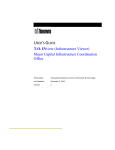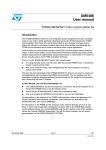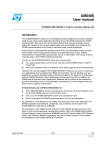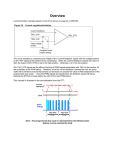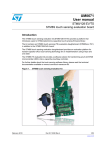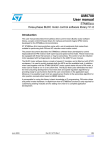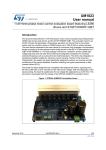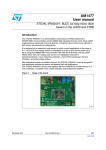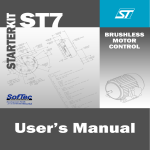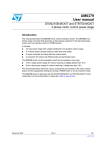Download Datasheet - STMicroelectronics
Transcript
UM0709 User Manual STM8/128-MCKIT motor control starter kit 1 Introduction The STM8/128-MCKIT starter kit is an integrated system designed to provide a complete, ready-to-use motor control application developed around the STMicroelectronics STM8 microcontroller. This starter kit is particularly suited to drive 3-phase brushless motors (either AC induction or permanent magnet types) and demonstrates how effectively the STM8 microcontrollers can be used in real-world motor control applications. ● Drive is based on scalar control (BLDC or ACIM) for three-phase motors. ● Position and/or speed measurement is implemented using Hall sensors or a tachometer. ● Sensorless control is also implemented. ● The inverter is driven using the PWM modulation technique. The STM8/128-MCKIT starter kit can be run in various ways: ● As a plug-and play demo, out of the box, with the provided BLDC motor, in sensorless speed control mode. ● With an AC induction motor, after reprogramming the microcontroller, in open loop or in speed control mode. However, the main advantage of the STM8/128-MCKIT is that you can use it to create your own applications and re-program the STM8 microcontroller. You can develop your own applications using the dedicated software libraries provided in the starter kit in conjunction with a third-party IDE and C compiler. This manual describes: ● The STM8/128-MCKIT starter kit components, and how to set up the hardware to run the provided BLDC motor or an AC induction motor. ● How to run the STM8/128-MCKIT starter kit in standalone mode. ● The BLDC daughterboard (MB843). For information about the STM8 microcontroller features, refer to the datasheet. The STM8 evaluation board features, peripherals, and connectors are described in the STM8/128EVAL user manual (UM0482). For information on the BLDC and AC induction motor software libraries and how to use them in motor control application development projects, refer to the STM8S three-phase BLDC software library (UM0708) and the STM8S three-phase AC induction motor software library user manual (UM0712) respectively. You will find these manuals, and all related documentation on the STM8/128-MCKIT CD-ROM. June 2009 Doc ID 15774 Rev 2 1/22 www.st.com Contents UM0709 Contents 1 Introduction . . . . . . . . . . . . . . . . . . . . . . . . . . . . . . . . . . . . . . . . . . . . . . . . 1 2 Safety warnings . . . . . . . . . . . . . . . . . . . . . . . . . . . . . . . . . . . . . . . . . . . . . 4 3 2.1 General . . . . . . . . . . . . . . . . . . . . . . . . . . . . . . . . . . . . . . . . . . . . . . . . . . . . 4 2.2 Intended use . . . . . . . . . . . . . . . . . . . . . . . . . . . . . . . . . . . . . . . . . . . . . . . 4 2.3 Operation . . . . . . . . . . . . . . . . . . . . . . . . . . . . . . . . . . . . . . . . . . . . . . . . . . 4 2.4 Important notice to users . . . . . . . . . . . . . . . . . . . . . . . . . . . . . . . . . . . . . . 4 STM8/128-MCKIT hardware setup . . . . . . . . . . . . . . . . . . . . . . . . . . . . . . 5 3.1 4 5 6 Package checklist . . . . . . . . . . . . . . . . . . . . . . . . . . . . . . . . . . . . . . . . . . . . 5 3.1.1 Hardware . . . . . . . . . . . . . . . . . . . . . . . . . . . . . . . . . . . . . . . . . . . . . . . . . 5 3.1.2 Software . . . . . . . . . . . . . . . . . . . . . . . . . . . . . . . . . . . . . . . . . . . . . . . . . . 6 3.1.3 Documentation . . . . . . . . . . . . . . . . . . . . . . . . . . . . . . . . . . . . . . . . . . . . . 6 3.1.4 Components not provided . . . . . . . . . . . . . . . . . . . . . . . . . . . . . . . . . . . . 6 3.2 Brushless DC motor (default) . . . . . . . . . . . . . . . . . . . . . . . . . . . . . . . . . . . 7 3.3 AC induction motor . . . . . . . . . . . . . . . . . . . . . . . . . . . . . . . . . . . . . . . . . . . 7 3.4 Hardware configuration for a BLDC motor (default) . . . . . . . . . . . . . . . . . . 8 3.5 Hardware configuration for an AC induction motor . . . . . . . . . . . . . . . . . . 11 3.6 Power supply connections . . . . . . . . . . . . . . . . . . . . . . . . . . . . . . . . . . . . 13 BLDC daughterboard MB843 . . . . . . . . . . . . . . . . . . . . . . . . . . . . . . . . . 14 4.1 Features . . . . . . . . . . . . . . . . . . . . . . . . . . . . . . . . . . . . . . . . . . . . . . . . . . 14 4.2 Layout . . . . . . . . . . . . . . . . . . . . . . . . . . . . . . . . . . . . . . . . . . . . . . . . . . . . 15 4.3 Jumper configuration . . . . . . . . . . . . . . . . . . . . . . . . . . . . . . . . . . . . . . . . 16 4.4 Schematic . . . . . . . . . . . . . . . . . . . . . . . . . . . . . . . . . . . . . . . . . . . . . . . . . 17 Running the starter kit . . . . . . . . . . . . . . . . . . . . . . . . . . . . . . . . . . . . . . 18 5.1 Running the BLDC motor . . . . . . . . . . . . . . . . . . . . . . . . . . . . . . . . . . . . . 18 5.2 Running the AC induction motor . . . . . . . . . . . . . . . . . . . . . . . . . . . . . . . 18 Creating your custom application . . . . . . . . . . . . . . . . . . . . . . . . . . . . . 19 Appendix A Additional information. . . . . . . . . . . . . . . . . . . . . . . . . . . . . . . . . . . . 20 2/22 Doc ID 15774 Rev 2 UM0709 Contents A.1 Modification of MB631 for BLDC drive . . . . . . . . . . . . . . . . . . . . . . . . . . . 20 A.2 Recommended reading . . . . . . . . . . . . . . . . . . . . . . . . . . . . . . . . . . . . . . . 20 A.3 Software upgrades . . . . . . . . . . . . . . . . . . . . . . . . . . . . . . . . . . . . . . . . . . 20 A.4 Getting technical support . . . . . . . . . . . . . . . . . . . . . . . . . . . . . . . . . . . . . 20 Revision history . . . . . . . . . . . . . . . . . . . . . . . . . . . . . . . . . . . . . . . . . . . . . . . . . . . . 21 Doc ID 15774 Rev 2 3/22 Safety warnings 2 Safety warnings 2.1 General UM0709 In operation, the STM8/128-MCKIT starter kit has non-insulated wires, moving or rotating parts (when connected to a motor), as well as hot surfaces. In case of improper use, incorrect installation or misuse, there is danger of serious personal injury and damage to property. All operations, installation and maintenance are to be carried out by skilled technical personnel (applicable accident prevention rules must be observed). When the power board is supplied with voltages greater than 30 V AC/DC, all of the board and components must be considered “hot”, and any contact with the board must be avoided. The operator should stay away from the board as well (risk of projection of material in case of components destruction, especially when powering the board with high voltages). The rotating parts of motors are also a source of danger. The STM8/128-MCKIT starter kit contains electrostatic sensitive components which may be damaged through improper use. Note: The board's power supply must be electrically insulated before connecting any cables that link the PC to the board, such as the STX-RLINK or a serial cable. Otherwise an earth/ground loop would occur, as there is no insulation board. 2.2 Intended use The STM8/128-MCKIT starter kit is made of components designed for demonstration purposes and must not be included in electrical installations or machinery. Instructions about the setup and use of the STM8/128-MCKIT starter kit must be strictly observed. 2.3 Operation After disconnecting the board from the voltage supply, several parts and power terminals must not be touched immediately because of possible energized capacitors or hot surfaces. 2.4 Important notice to users While every effort has been made to ensure the accuracy of all information in this document, STMicroelectronics assumes no liability to any party for any loss or damage caused by errors or omissions or by statements of any kind in this document, its updates, supplements, or special editions, whether such errors are omissions or statements resulting from negligence, accident, or any other cause. 4/22 Doc ID 15774 Rev 2 UM0709 3 STM8/128-MCKIT hardware setup STM8/128-MCKIT hardware setup This section provides a detailed description of the components included in the STM8/128MCKIT starter kit. It also describes the default settings for a brushless DC motor (BLDC), and explains how to change them to use an AC induction motor. 3.1 Package checklist Figure 1 shows the layout and connections of the major components of the STM8/128MCKIT starter kit. Figure 1. 3.1.1 STM8/128-MCKIT layout Hardware The STM8/128-MCKIT starter kit includes the following items: ● The MB459B power board (1): This board is described in the MB459B power board user manual (UM0379) provided on the STM8/128-MCKIT CD-ROM. ● The MB631 STM8 evaluation board (2): This board is described in the STM8/128-EVAL user manual (UM0482) provided on the STM8/128-MCKIT CD-ROM. ● An MB843 BLDC daughterboard (3): This board is described in the chapter BLDC daughterboard MB843. The purpose of the BLDC daughterboard is to implement the BEMF detecting network and the current regulation/limitation network. ● An STX-RLink USB–SWIM debugger (4): The RAISONANCE STX-RLink USB-JTAG debugger allows you to reprogram the Flash memory of the STM8 microcontroller and to debug the software before using the application in standalone mode. ● A 24V DC SHINANO BLDC motor (5): The motor included in the STM8/128-MCKIT starter kit is a SHINANO inner rotor type 4-pole brushless DC motor with Hall sensor and encoder. For electrical specifications and mechanical dimensions, refer to the SHINANO datasheets on the STM8/128-MCKIT CD-ROM. Doc ID 15774 Rev 2 5/22 STM8/128-MCKIT hardware setup 3.1.2 UM0709 ● An auxiliary power supply block TR30R (6) ● The following cables: – Motor cables (7) – A motor connector HE10 34-pin cable (8) – A USB cable (9) – One SWIM cable and the related adapter (10) – An auxiliary connector for BLDC sensorless HE10 20-pin cable (11) ● A bag with three 0.1 ohm resistors is included to configure the MB459B board to increase the maximum motor nominal current level up to 5 amps. ● The STM3210B-MCKIT CD-ROM. Software The STM8/128-MCKIT CD-ROM includes the BLDC and AC induction motor software libraries. When you receive the STM8/128-MCKIT, the STM8 microcontroller is programmed by default with the BLDC sensorless firmware. 3.1.3 Documentation The STM8/128-MCKIT CD-ROM also includes the following product documentation in PDF format: ● STM8Sxxx access line and performance line datasheets ● STM8Sxxx reference manual ● STM8/128-MCKIT motor control kit user manual (UM0709, the present manual) ● STM8S three-phase BLDC software library v1.0 user manual (UM0708) ● STM8S three-phase AC induction motor software library v1.0 user manual (UM0712) ● STM8/128-EVAL user manual (UM0482) ● MB459B power board user manual (UM0379) ● SHINANO motor datasheet. In the box with the STM8/128-MCKIT, there is also: 3.1.4 ● The MCD product finder ● Product flyers and brochures ● The MCD miniROM ● A guarantee record card Components not provided The STM8/128-MCKIT starter kit does not include: 6/22 ● A power supply: To use the STM8/128-MCKIT starter kit with the provided BLDC motor, you need a 24V-3A minimum power supply. ● An AC induction motor: The STM8/128-MCKIT can operate with an AC induction motor. The provided firmware is designed to operate with the SELNI induction motor. It can be ordered as an accessory with the following order code: ST7MC-MOT/IND. To use the STM8/128-MCKIT starter kit with the Selni AC induction motor, you need a 42 V DC or 32 Veff AC power supply (polarity not important, earth connection recommended). Doc ID 15774 Rev 2 UM0709 3.2 STM8/128-MCKIT hardware setup Brushless DC motor (default) The brushless DC motor (BLDC) is a rotating electric machine where the stator is a classic 3-phase stator like that of an induction motor and the rotor has surface-mounted permanent magnets. In this respect, the BLDC motor is equivalent to an induction motor where the air gap magnetic field is produced by a permanent magnet. The use of a permanent magnet to generate a substantial air gap magnetic flux makes it possible to design highly efficient motors. A BLDC motor is driven by trapezoidal currents coupled with the given rotor position. The generated stator flux together with the rotor flux, which is generated by a rotor magnet, defines the torque, and thus speed, of the motor. The trapezoidal currents have to be applied to the 3-phase winding system in a way that angle between the stator flux and the rotor flux is kept close to 90° to get the maximum generated torque. To meet this criterion, the motor requires electronic control for proper operation. For a common 3-phase BLDC motor, a standard 3-phase power stage is used. The same power stage is used for AC induction and BLDC motors. The power stage utilizes six power transistors with independent switching. The power transistors are switched in the also called six step operation. 3.3 AC induction motor The AC induction motor is a rotating electric machine designed to operate from a 3-phase source of alternating voltage. The stator is a classic 3-phase stator with the winding displaced by 120°. The most common type of induction motor has a squirrel cage rotor in which aluminum conductors or bars are shorted together at both ends of the rotor by cast aluminum end rings. When three currents flow through the three symmetrically placed windings, a sinusoidally distributed air gap flux generating the rotor current is produced. The interaction of the sinusoidally distributed air gap flux and induced rotor currents produces a torque on the rotor. The mechanical angular velocity of the rotor is lower then the angular velocity of the flux wave by so called slip velocity. In adjustable speed applications, AC induction motors are powered by inverters. The inverter converts DC power to AC power at the required frequency and amplitude. The inverter consists of three half-bridge units where the upper and lower switches are controlled complementarily. As the power device's turn-off time is longer than its turn-on time, some dead-time must be inserted between the turn-off of one transistor of the half bridge and turn-on of its complementary device. The output voltage is mostly created by a pulse width modulation (PWM) technique. The 3phase voltage waves are shifted 120° to each other and thus a 3-phase motor can be supplied. Doc ID 15774 Rev 2 7/22 STM8/128-MCKIT hardware setup 3.4 UM0709 Hardware configuration for a BLDC motor (default) This section describes the procedure for operating the STM8/128-MCKIT with a BLDC motor. The default settings that are present on the STM8 evaluation board and on the power board when you receive the STM8/128-MCKIT starter kit are intended for a BLDC motor. When you are using the BLDC motor, follow these steps: 1. Verify that all the jumpers on the power board (MB459B) are in their default position. Refer to Table 1: MB459B power board jumper settings for a BLDC motor (default) for information on jumper settings, and if necessary, to the MB459B power board User Manual for the location of the jumpers on the board. 2. Verify that all of the STM8 evaluation board (MB631) jumpers are in their default position. Refer to Table 2: STM8 evaluation board jumper settings for a BLDC motor (default) for information on jumper settings, and if necessary, to the STM8/128-EVAL board User Manual for the location of jumpers on the board. 3. Verify that all of the BLDC daughterboard (MB843) jumpers are in their default position. Refer to Table 3: BLDC daughterboard MB843 jumper settings for a BLDC motor (default) for information on jumper settings. 4. Verify that the BLDC daughterboard (MB843) is fitted on top of STM8/128-EVAL board through the CN1 and CN5 connectors (see Figure 2). 5. Verify that the adapter board (MB844) is fitted on top of power board (MB459B) through the J4 connector (see Figure 2). 6. Verify that the BLDC daughterboard (MB843) and the adapter board (MB844) are connected with the provided 20-pin auxiliary connector cable for BLDC sensorless (see Figure 2). 7. Verify that the BLDC motor cables are correctly plugged into the power board's MOTOR connectors (J5 and J8). The power board (MB459B), the STM8 evaluation board (MB631), and the provided BLDC motor are already assembled together over a metal support when you receive the kit. 8. Power up the STM8 evaluation board with the auxiliary power supply block TR30R. 9. Power up the power board by connecting the output terminals of your DC power supply to the MAINS connector (J3). The provided voltage must be 24 V DC and your power supply must be able to provide a current of 3 A. The STM8/128-MCKIT is now ready to run with the BLDC motor. 8/22 Doc ID 15774 Rev 2 UM0709 STM8/128-MCKIT hardware setup Figure 2. STM8/128-MCKIT assembly Caution: Before supplying the board, double check proper connections, make sure that there are no metal parts on, below or around the PCB and that there are no undesired earth/ground loops due to measuring equipment such as an oscilloscope. Caution: Be sure that the STM8/128-EVAL used is marked with (MB631/2) or with (MB631); in the second case you must also check the required modifications reported in the Appendix Section A.1: Modification of MB631 for BLDC drive. Note: Not all the default positions of the jumper are coincident with the silk-screen printing. The jumper settings that are different from the silk-screen printing are highlighted in the Table 1: MB459B power board jumper settings for a BLDC motor (default) and Table 2: STM8 evaluation board jumper settings for a BLDC motor (default). Doc ID 15774 Rev 2 9/22 STM8/128-MCKIT hardware setup Table 1. MB459B power board jumper settings for a BLDC motor (default) Jumper Setting for the SHINANO 24V BLDC motor provided Setting for a high-voltage BLDC motor W1 “<35V only” “<35V only” or “HIGH VOLTAGE” W4 Not present W5 Present W6 Present W7 Not present W8 Not present W9 Not present W10 Present and soldered on reverse position of silk-screen printing W11 Present W12 Not present W13 Not present W14 Present W15 Not present W16 Present and set on reverse position of silk-screen printing W17 Not present W18 Not present W19 Not present Table 2. STM8 evaluation board jumper settings for a BLDC motor (default) Jumper Setting JP1 Present between 1-2 JP2 Present JP3 Set to PSU position to supply the STM8 evaluation board through the jack (CN6) And set to DTB position to supply the BLDC daughterboard (MB843) JP4 Present JP5 Not present JP6 Present between 1-2 JP7 Not present JP8 Present JP9 Not present JP10 Present JP11 Present between 2-3 JP12 Present between 1-2 JP13 JP14 10/22 UM0709 Present between 1-2 to configure the HW for the DAC functionality Or present between 2-3 to configure the HW for the dissipative brake Not present Doc ID 15774 Rev 2 UM0709 STM8/128-MCKIT hardware setup Table 3. 3.5 BLDC daughterboard MB843 jumper settings for a BLDC motor (default) Jumper Setting J1 Present and set on default position of silk-screen printing J2 Present and set on default position of silk-screen printing J3 Present and set on default position of silk-screen printing J4 Present and set on default position of silk-screen printing J5 Present and set on default position of silk-screen printing (SENSORLESS) J13 Present and set on default position of silk-screen printing (VARIABLE) Hardware configuration for an AC induction motor This section describes the procedure for operating the STM8/128-MCKIT with an AC induction motor. You must change the default settings that are present on the STM8 evaluation board and on the power board when you receive the STM8/128-MCKIT starter kit because they are intended for a PMSM motor. When you are running the AC induction motor, follow these steps: 1. Remove the BLDC daughterboard (MB843) from the STM8/128-EVAL evaluation board (MB631). 2. Remove the adapter board (MB844) from the power board (MB459B). 3. Change the jumpers on the power board (MB459B) to the settings required for running with an AC induction motor. Refer to Table 4: MB459B power board jumper settings for an AC induction motor for information on jumper settings, and if necessary, to the MB459B power board user manual for the location of the jumpers on the board. 4. If the peak value of the motor phase current should be greater than 3 ampere, replace the R4 shunt resistor on the power board (MB459B) by the 0.1 ohm resistor included in the bag delivered with the kit. 5. Verify that the jumpers on the STM8/128-EVAL evaluation board (MB631) are in their default position. Refer to Table 5: STM8 eval board jumper settings for an AC induction motor for information on jumper settings, and if necessary, to the STM8/128-EVAL board user manual for the location of jumpers on the board. 6. Disconnect the PMSM motor from the power board's MOTOR connectors (J5 and J8). The power board (MB459B), the STM8/128-EVAL evaluation board (MB631), and the provided PMSM motor are already assembled together over a metal support when you receive the kit. 7. Connect your AC induction motor to the power board by connecting the three phases to the J5 connector, and the tachometer cables to the J6 connector. 8. Power up STM8/128-EVAL evaluation board with auxiliary power supply block TR30R. 9. Power up the power board by connecting the output terminals of your DC power supply to the MAINS connector (J3). The provided voltage must not be higher than 42 V DC or 32 Veff AC (GND recommended). After re-programming the STM8S microcontroller with the ACIM motor control firmware, the STM8/128-EVAL is now ready to run with your AC induction motor. Caution: Before supplying the board, double check proper connections, make sure that there are no metal parts on, below or around the PCB and that there are no undesired earth/ground loops due to measuring equipment such as an oscilloscope. Doc ID 15774 Rev 2 11/22 STM8/128-MCKIT hardware setup Table 4. 12/22 UM0709 MB459B power board jumper settings for an AC induction motor Jumper Settings for AC induction motor with tachometer feedback W1 “<35V only” or “HIGH VOLTAGE” W4 Not present W5 Present W6 Present W7 Not present W8 Not present W9 Not present W10 Present and soldered on reverse position of silk-screen printing W11 Present W12 Present W13 Not present W14 Not Present W15 Not present W16 Present and set on reverse position of silk-screen printing W17 Not present W18 Not present W19 Not present Doc ID 15774 Rev 2 UM0709 STM8/128-MCKIT hardware setup Table 5. STM8 eval board jumper settings for an AC induction motor Jumper Setting JP1 Present between 1-2 JP2 Present JP3 Set to PSU position to supply the STM8 evaluation board through the jack (CN6) JP4 Present JP5 Not present JP6 Present between 1-2 JP7 Not present JP8 Present JP9 Present, if required to filter the noise from the tachogenerator signal JP10 Present JP11 Present between 2-3 JP12 Present between 1-2 JP13 Present between 1-2 to configure the HW for the DAC functionality Or present between 2-3 to configure the HW for the dissipative brake JP14 Not present Note: The jumper settings that are different from the silk-screen printing are highlighted in the Table 4: MB459B power board jumper settings for an AC induction motor and Table 5: STM8 eval board jumper settings for an AC induction motor. 3.6 Power supply connections J1 connector of power board (MB459B) provides a completely independent control of the DC bus voltage (power) and the +15 V supply for the gate drivers. This is interesting for development purposes, when one needs to smoothly increase the motor's operating voltage from zero, while the gate drivers are operating with their nominal supply. When supplying the power stage with an external +15 V power supply using the J1 connector, special care must be taken that: 1. No jumpers are connected on jumper W1. 2. The short circuit that replaces the D3 diode footprint must be open. This is to avoid having reverse current in the L7815 voltage regulator. Doc ID 15774 Rev 2 13/22 BLDC daughterboard MB843 UM0709 4 BLDC daughterboard MB843 4.1 Features The BLDC daughterboard MB843 is an extension of the STM8/128-EVAL evaluation board MB631 required to implement the BLDC drive. It includes: ● A BEMF detection network, ● A current regulation/regulation network, ● A neutral voltage reconstruction network. The board has been designed to be compatible with the voltage level applicable to the power board MB459B (“<35V only” or “HIGH VOLTAGE”). The BEMF detection network allows the following strategies of BEMF sampling: ● BEMF sampling during off time (ST patented method), ● BEMF sampling during on time, ● Dynamic method based on the duty cycle applied. For more details see the STM8S three-phase BLDC software library v1.0 (UM0708). Note: For applications that require a limited range of motor speed, for example if the ratio between maximum and minimum speed is below 4, it is possible to replace the BEMF detecting network with a simple resistive voltage divider. The current regulation/regulation network is used to adapt the signal to perform the current control in the BLDC drive. Control is made possible by a special characteristic of the STM8 microcontroller. See for more details the STM8S three-phase BLDC software library v1.0 (UM0708). The neutral voltage reconstruction network is used to reconstruct the neutral voltage (also called star point) of the motor in order to perform the BEMF sampling during the on time. Two strategies of the neutral point reconstruction are implemented by the board: ● Bus voltage partitioning, ● Star point reconstruction starting from the motor phases. Note: It is possible to configure either method (see Section 4.3: Jumper configuration) but only the first is implemented by the firmware. Note: Even if bus partitioning is also performed in the power board MB459B, the partitioning performed by the MB843 makes use of a voltage partitioning that allows a better resolution in the neutral voltage reconstruction. The board is easily configurable to run the BLDC drive in sensorless mode, or to use the Hall sensors as position/speed feedback. 14/22 Doc ID 15774 Rev 2 UM0709 4.2 BLDC daughterboard MB843 Layout Figure 3. BLDC daughterboard MB843 layout 1. J8-J12 connector for the 20-pin auxiliary connector cable for BLDC sensorless. This is used to provide the three motor phase voltage signals and the bus voltage signal to the daughterboard MB843. 2. Auxiliary phase voltage connector CN2 (optional input). It can be used alternatively to the J8-J12 connecting directly the motor phase voltage signals using custom wire connections. Using that connector you can tighten the cables with a screwdriver connecting motor phase A in the pin 1, motor phase B in the pin 2, motor phase C in pin 3, the DC bus voltage in pin 4 and the ground in pin 5. 3. Jumper J5 sets sensorless or sensored configuration. 4. Jumper J13 sets the current reference or limitation. 5. Potentiometer P1 sets the fixed current limitation. 6. Jumper J4 7. Jumper J3 8. Jumper J2 9. Jumper J1 Doc ID 15774 Rev 2 15/22 BLDC daughterboard MB843 4.3 UM0709 Jumper configuration Table 6 describes the jumpers. Table 6. Jumper BLDC daughterboard MB843 jumper settings Setting Description Selects the motor neutral voltage reconstruction network J1 Set to default position of silkBus voltage partitioning screen printing Set to reverse position of silk-screen printing Star point reconstruction starting from the motor phases Configures the BEMF attenuation network Three GPIOs perform the dynamic attenuation of the BEMF Set to default position of silksignal this allows the sampling during off time, during on screen printing time and the dynamic selection of the two methods. J2,J3,J4 Set to reverse position of silk-screen printing Fixes the BEMF signals attenuation and frees the three GPIOs Not present Removes the attenuation of the BEMF signals Sets sensorless or sensored configuration J5 Set to default position of silkSets the sensorless configuration screen printing Set to reverse position of silk-screen printing Sets the Hall sensor configuration Sets the current reference or limitation J13 With this setting the current reference or limitation is Set to default position of silk- dynamically selected by the microcontroller using a filtered screen printing PWM signal. Is the only configuration that allows the current regulation. Set to reverse position of silk-screen printing 16/22 The current limitation is fixed and the potentiometer P1 is used to set this value. In this case is possible to free the microcontroller PWM resource. Doc ID 15774 Rev 2 2 1 FASE B Bus Voltage Phase C Phase B J6 2 4 6 8 10 12 14 16 18 20 22 24 26 28 30 32 34 36 38 40 42 44 46 48 50 Header 25x2 Pl aced on bot t om 1 3 5 7 9 11 13 15 17 19 21 23 25 27 29 31 33 35 37 39 41 43 45 47 49 Hi gh Vol t age ar ea cl ear ance must be r espect ed ETR GPIOB 1 2 3 4 5 Optional Input CN2 D5V MCIB CR_Sensored GPIOA GPIOC Phase A Phase B Phase C Bus Voltage IB Mal e c onnec t or t o f l at c abl e ( pi t c h 200mi l s ) J12 GND 1 2 3 4 J11 BUS VOLTAGE 2 1 J10 FASE C J9 2 1 1 3 5 7 9 11 13 15 17 19 21 23 25 27 29 31 33 35 37 39 41 43 45 47 49 2 4 6 8 10 12 14 16 18 20 22 24 26 28 30 32 34 36 38 40 42 44 46 48 50 Header 25x2 Pl aced on bot t om J7 Phase C Phase B Phase A D5V R15 180k R19 1k R9 180k R11 1k R1 180k R6 1k IB MCIA MCIC Neutral Point Iref 3 D5V R36 1M D5V R37 1M C9 100nF CR_Sensorless 2 3 1 4 3 D5V J4 - + 1 D5V MCIC MCIB MCIA C8 100nF 3 1 FI XED VARI ABLE 2 JUMPER J13 ETR C7 4.7uF 16V TS3021ILT U1 R41 10k Q3 BC817-25 R40 10k Q2 BC817-25 R39 10k Q1 BC817-25 SENSORED 2 D5V D5V D5V SENSORLESS JUMPER J5 R35 10M P1 100k CR_Sensored J2 J3 R38 1M R20R23 R21 68k 68k 68k R34 33k 2 CR_Sensorless 1N4005 R17 180k D3 1N4005 R12 180k D2 1N4005 R3 180k D1 D5V 2 Phase A 3 2 1 3 FASE A 1 GPIOA 1 GPIOB 1 GPIOC Doc ID 15774 Rev 2 5 Iref Bus Voltage Phase C Phase B Phase A R27 180k R28 180k Date: Size B Title R24 180k R13 180k R5 180k R32 27k R25 39k C5 NC C4 NC Tuesday , March 17, 2009 Document Number MB843 R18 180k 3 1 J1 Sheet JUMPER 2 1 of 1 Rev A.1 Neutral Point Figure 4. J8 + 4.4 2 UM0709 BLDC daughterboard MB843 Schematic BLDC daughterboard MB843 schematic 17/22 Running the starter kit UM0709 5 Running the starter kit 5.1 Running the BLDC motor See STM8S three-phase BLDC software library v1.0 (UM0708) Chapter 2: Running the demo program. 5.2 Running the AC induction motor See STM8S three-phase AC induction motor software library v1.0 (UM0712) Chapter 2: Running the demo program. 18/22 Doc ID 15774 Rev 2 UM0709 6 Creating your custom application Creating your custom application The main benefit of the STM8/128-MCKIT starter kit is that you can use it to create your own applications and reprogram the STM8 microcontroller. In the toolkit, you have the source files for BLDC and AC induction motors, and the STM8 standard library. They are intended to provide a sound basis for your own application developments. Do not hesitate to fine-tune them to suit your specific requirements. These libraries are provided with ST Visual Develop v.4.1.1 workspaces compatible with Cosmic compiler v. 4.2.7. You can set up your workspace manually for any other toolchain. Doc ID 15774 Rev 2 19/22 Additional information Appendix A A.1 UM0709 Additional information Modification of MB631 for BLDC drive It is possible to assemble the system of STM8/128-MCKIT by acquiring separately the various parts described in Chapter 3: STM8/128-MCKIT hardware setup or by replacing it with compatible hardware. The control board released with the STM8/128-MCKIT (marked with MB631/2) has been modified to work with the BLDC firmware. It is possible to use a standard STM8 evaluation board marked with MB631 with the BLDC firmware after performing the following modifications: A.2 ● Remove R21, R30, R58, R59, R75, R99 and R103. ● Remove pins 15, 19 and 28 on the CN10 connector. Recommended reading This documentation describes how to use the STM8/128-MCKIT starter kit. Additional information can be found in the following documents: A.3 ● STM8Sxxx access line and performance line datasheets ● STM8Sxxx reference manuals ● STMicroelectronics motor control application notes ● STM8S three-phase BLDC software library v1.0 (UM0708) ● STM8S three-phase AC induction motor software library v1.0 (UM0712) ● STM8/128-EVAL user manual (UM0482) ● MB459B power board user manual (UM0379) ● Most of the above documents are present on the STM3210B-MCKIT CD-ROM Software upgrades The latest versions of the STM8 motor control libraries are available free of charge, from our sales offices. A.4 Getting technical support Technical assistance is provided free to all customers. For technical assistance, documentation and information about products and services, please refer to your local STMicroelectronics partner. 20/22 Doc ID 15774 Rev 2 UM0709 Revision history Revision history Table 7. Document revision history Date Revision Changes 12-Jun-2009 1 Initial release. 22-Jun-2009 2 Added note to Section 2.1. Doc ID 15774 Rev 2 21/22 UM0709 Please Read Carefully: Information in this document is provided solely in connection with ST products. STMicroelectronics NV and its subsidiaries (“ST”) reserve the right to make changes, corrections, modifications or improvements, to this document, and the products and services described herein at any time, without notice. All ST products are sold pursuant to ST’s terms and conditions of sale. Purchasers are solely responsible for the choice, selection and use of the ST products and services described herein, and ST assumes no liability whatsoever relating to the choice, selection or use of the ST products and services described herein. No license, express or implied, by estoppel or otherwise, to any intellectual property rights is granted under this document. If any part of this document refers to any third party products or services it shall not be deemed a license grant by ST for the use of such third party products or services, or any intellectual property contained therein or considered as a warranty covering the use in any manner whatsoever of such third party products or services or any intellectual property contained therein. UNLESS OTHERWISE SET FORTH IN ST’S TERMS AND CONDITIONS OF SALE ST DISCLAIMS ANY EXPRESS OR IMPLIED WARRANTY WITH RESPECT TO THE USE AND/OR SALE OF ST PRODUCTS INCLUDING WITHOUT LIMITATION IMPLIED WARRANTIES OF MERCHANTABILITY, FITNESS FOR A PARTICULAR PURPOSE (AND THEIR EQUIVALENTS UNDER THE LAWS OF ANY JURISDICTION), OR INFRINGEMENT OF ANY PATENT, COPYRIGHT OR OTHER INTELLECTUAL PROPERTY RIGHT. UNLESS EXPRESSLY APPROVED IN WRITING BY AN AUTHORIZED ST REPRESENTATIVE, ST PRODUCTS ARE NOT RECOMMENDED, AUTHORIZED OR WARRANTED FOR USE IN MILITARY, AIR CRAFT, SPACE, LIFE SAVING, OR LIFE SUSTAINING APPLICATIONS, NOR IN PRODUCTS OR SYSTEMS WHERE FAILURE OR MALFUNCTION MAY RESULT IN PERSONAL INJURY, DEATH, OR SEVERE PROPERTY OR ENVIRONMENTAL DAMAGE. ST PRODUCTS WHICH ARE NOT SPECIFIED AS "AUTOMOTIVE GRADE" MAY ONLY BE USED IN AUTOMOTIVE APPLICATIONS AT USER’S OWN RISK. Resale of ST products with provisions different from the statements and/or technical features set forth in this document shall immediately void any warranty granted by ST for the ST product or service described herein and shall not create or extend in any manner whatsoever, any liability of ST. ST and the ST logo are trademarks or registered trademarks of ST in various countries. Information in this document supersedes and replaces all information previously supplied. The ST logo is a registered trademark of STMicroelectronics. All other names are the property of their respective owners. © 2009 STMicroelectronics - All rights reserved STMicroelectronics group of companies Australia - Belgium - Brazil - Canada - China - Czech Republic - Finland - France - Germany - Hong Kong - India - Israel - Italy - Japan Malaysia - Malta - Morocco - Philippines - Singapore - Spain - Sweden - Switzerland - United Kingdom - United States of America www.st.com 22/22 Doc ID 15774 Rev 2






















